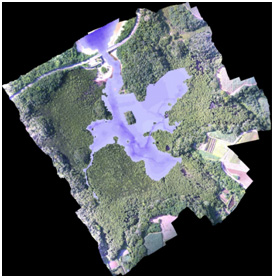伊勢湾流域圏における水・物質循環
Ise Bay is one of the major semi-enclosed bays in Japan. It suffers from steadily worsening eutrophication caused by the inflow of nitrogen from the surrounding rivers including Kiso-Sansen Rivers. This gives rise to red tides and hypoxic water mass and makes it even more urgent that the quality of water in Ise Bay be improved. For the future management and continuous utilization of the coastal zone, it will be necessary to implement not only quantitative but also qualitative management for pollutant loadings. In addition, it is projected that river discharge regimes are to be changed because of global warming at the end of this century.
To project how climate change and landuse change would impact on nutrient loading to Ise Bay from its catchments, we are now constructing a comprehensive numerical simulation model on aquatic systems which are the continuum of water flows from headwaters to oceans. The main objective of constructing the model is to simulate nitrogen, phosphorous and organic carbon load from rivers and to simulate the effect of these nutrients loads on dynamics of primary productivity of Ise Bay.

マングローブの淡水・塩水流動とDICの挙動のモデル化
 マングローブ林は地球上の森林生態系の中で最もCarbon-richで、特異的に大きなNEPを持つことが明らかになり、地球温暖化問題を背景として大きな注目が集まっている。加えて、流域という視点でみたとき、マングローブ林は陸域と海域との接合部に成立しているため、炭素のみならず、集水域から輸送される水・物質が集積する場所ともなっている。同時に、潮位変動と河川流入水の流入パターンとが複雑な水流動場を作り出し、台風や大潮などのイベント時には、大きく水・物質を海洋との間で交換するものと考えられる。
マングローブ林は地球上の森林生態系の中で最もCarbon-richで、特異的に大きなNEPを持つことが明らかになり、地球温暖化問題を背景として大きな注目が集まっている。加えて、流域という視点でみたとき、マングローブ林は陸域と海域との接合部に成立しているため、炭素のみならず、集水域から輸送される水・物質が集積する場所ともなっている。同時に、潮位変動と河川流入水の流入パターンとが複雑な水流動場を作り出し、台風や大潮などのイベント時には、大きく水・物質を海洋との間で交換するものと考えられる。
つまり、陸域と海洋との間の緩衝帯のような役割を果たしつつ、たとえば大きな降雨イベント時には、海洋に対して時に大きなパルス源ともなりうるのがマングローブを含む沿岸域の生態系の特徴である。本研究の目的は、石垣島吹通川流域を対象として、このようにダイナミックに変動するマングローブ林と海洋との間の水・物質交換をモデル化することにある。
